In yet another thrilling Clásico encounter, Real Madrid secured a late victory over Barcelona, further solidifying their claim to the La Liga title. Heading into the Santiago Bernabéu with an already significant eight-point deficit, Barcelona faced an uphill battle that seemed nearly insurmountable.
With only six matches remaining after this showdown, a double-digit point difference would undoubtedly set the stage for a title celebration in the capital. Real Madrid appears destined for the championship crown, not solely due to their exceptional skills but also owing to the absence of a formidable contender in the league.
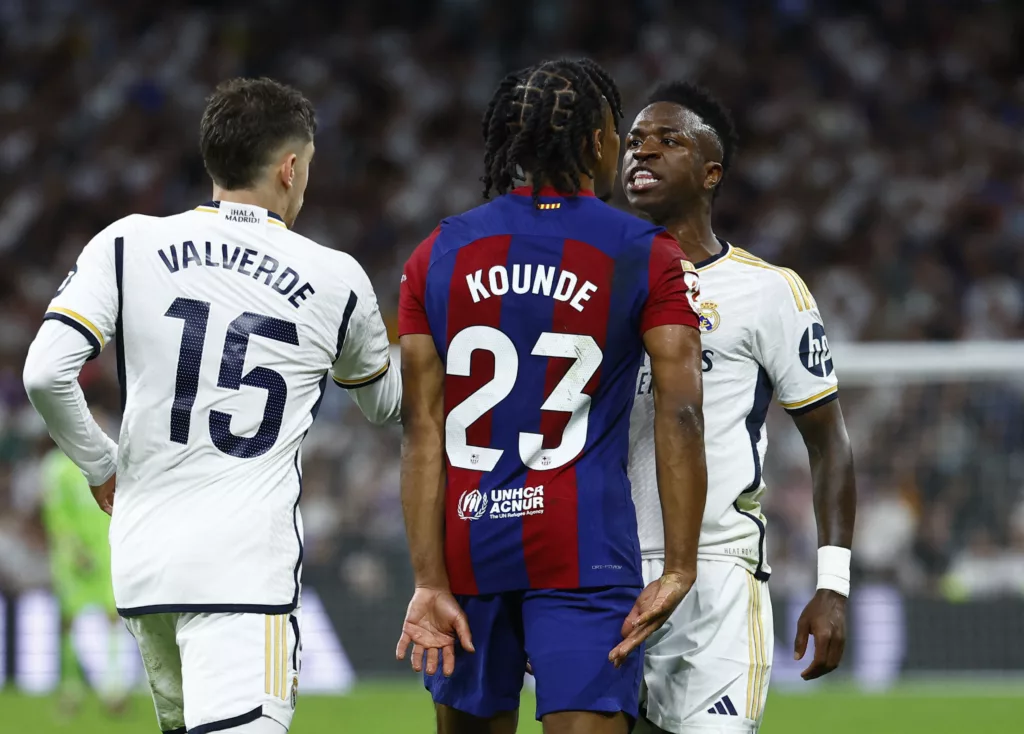
Atlético Madrid’s inconsistent performances amidst a season of tactical evolution, the fleeting Girona fairytale, and Barcelona’s struggle with various issues from the outset have all contributed to this narrative. While Barcelona’s inability to overcome the likely champions may not come as a shock, their commendable effort in challenging them deserves recognition.
The clash between Real Madrid and Barcelona is always highly anticipated, and the recent encounter on April 21, 2024, at the Santiago Bernabéu Stadium was no exception. In this tactical analysis, we delve deep into the strategies employed by both teams and the key factors that influenced the outcome of the match.
-
When is Barcelona’s next match?
Barcelona’s next match is on Tuesday 30th April 2024 against Valencia at 12:30 am(IST).
Real Madrid’s Tactical Innovation
Carlo Ancelotti’s tactical innovation took center stage as Real Madrid fielded a lineup featuring six midfielders. This bold move saw Valverde, Modric, Kroos, and Bellingham forming a diamond midfield, with Tchouameni and Camavinga adopting unconventional roles in the backline. Ancelotti’s foresight, as evidenced by his prior comments, suggests meticulous planning behind this strategic setup.
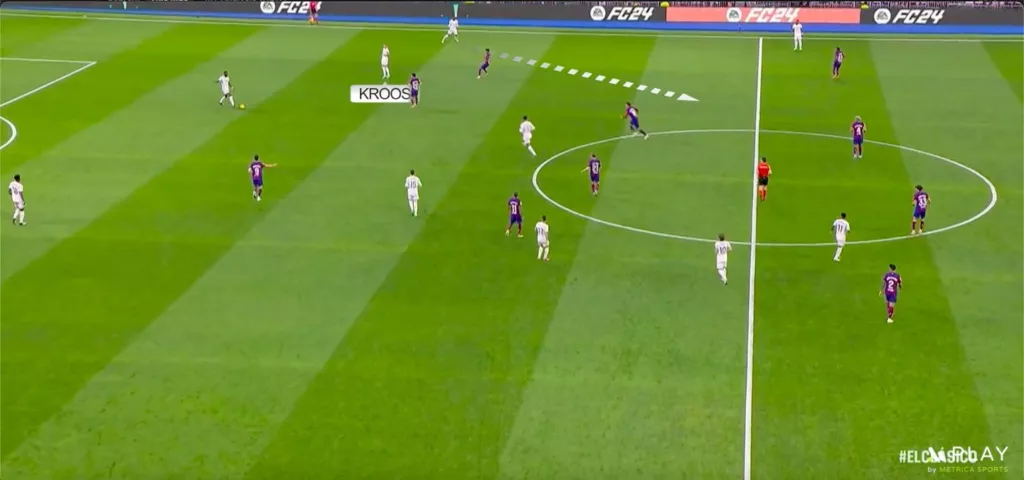
Fluidity and Versatility in Midfield
Real Madrid’s midfield displayed remarkable fluidity and versatility throughout the game. Kroos’s tendency to drift wide allowed Camavinga to surge forward centrally, contributing to Real Madrid’s buildup play. Bellingham and Modric showcased their adaptability by seamlessly transitioning between advanced positions and deeper roles, facilitating ball progression and maintaining control in midfield.
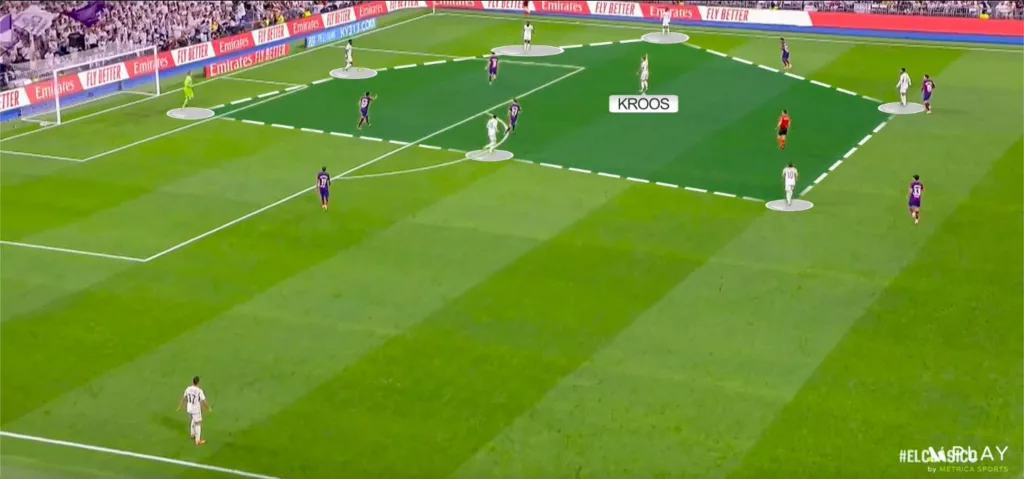
Valverde’s Dual Role
Federico Valverde’s performance epitomized Real Madrid’s tactical dynamism. While nominally deployed as a defensive midfielder, Valverde frequently surged forward, complementing Kroos in the buildup and adding an extra dimension to Real Madrid’s attacking play. His ability to seamlessly transition between defensive and offensive duties showcased his versatility and tactical intelligence.
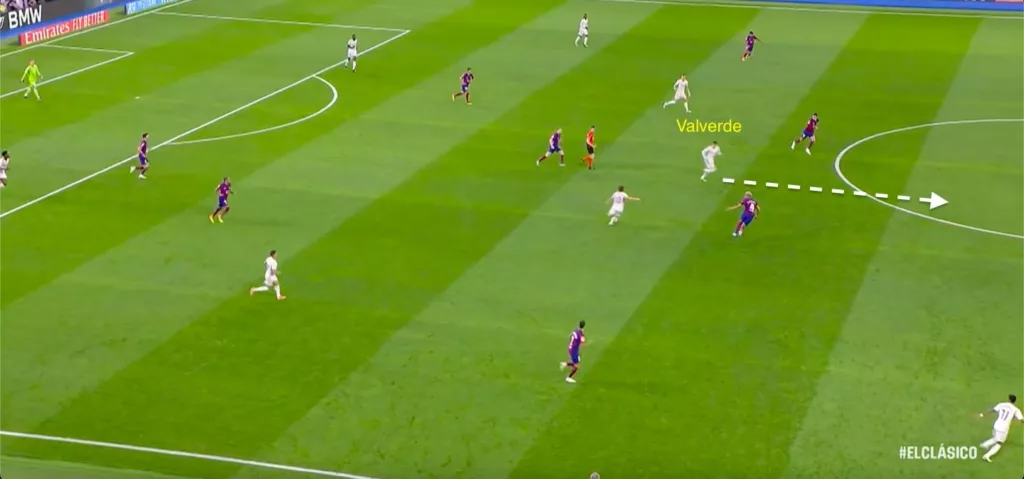
Tchouameni’s Influence from Defense to Attack
Despite occupying a defensive position in the backline, Tchouameni’s influence extended far beyond traditional defensive duties. Acting as an auxiliary midfielder, Tchouameni seamlessly transitioned from defense to attack, providing Real Madrid with numerical superiority in midfield and contributing to their fluid ball circulation and penetration.
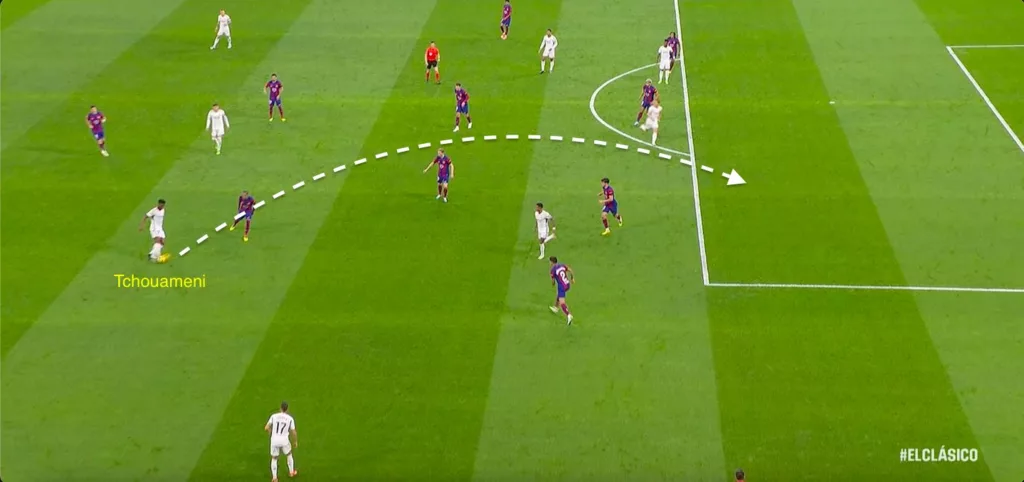
Real Madrid’s Expansive Attacking Play
Real Madrid’s attacking strategy focused on exploiting space and creating overloads, particularly on the flanks. They capitalized on quick ball circulation and dynamic movement to stretch Barcelona’s defense and create scoring opportunities. With an emphasis on combining in close proximity and exploiting 1v1 situations, Real Madrid’s attacking play was fluid and incisive.
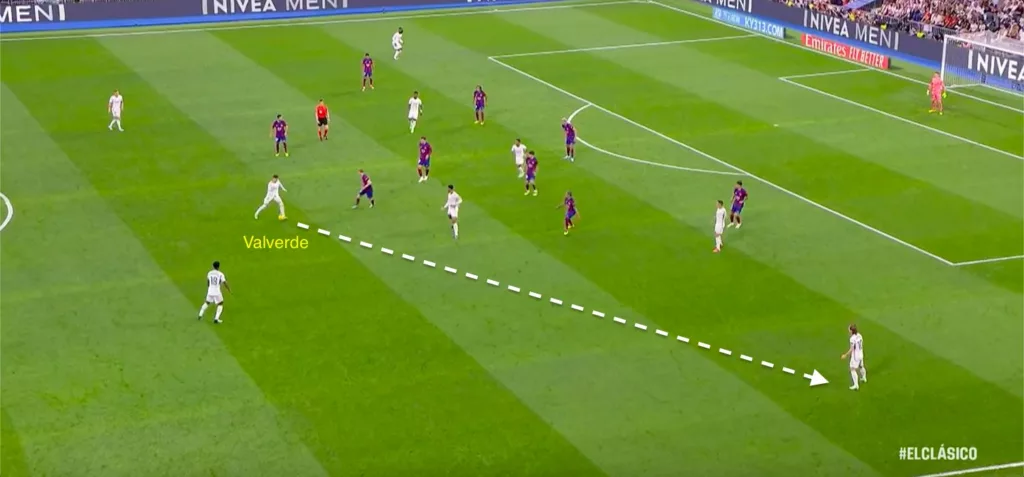
Barcelona’s Defensive Vulnerabilities
In contrast to Real Madrid’s tactical cohesion, Barcelona struggled defensively, particularly in tracking runners and closing down spaces. Their passive defensive approach, characterized by excessive distances between players and a lack of collective tension, allowed Real Madrid to exploit gaps and penetrate their defense with relative ease.
Addressing Madrid’s Pressing Flaws: A Key Objective for Los Blancos in the Summer
Carlo Ancelotti’s tactical approach at Real Madrid has often been lauded for its flexibility and the freedom it affords to players on the pitch. This approach, coupled with the exceptional talent within the squad, has resulted in a style of play that is both captivating and challenging for opponents to defend against. However, while Madrid’s attacking prowess is widely recognized, their defensive vulnerabilities, particularly in pressing situations, have been exposed on numerous occasions throughout the season.
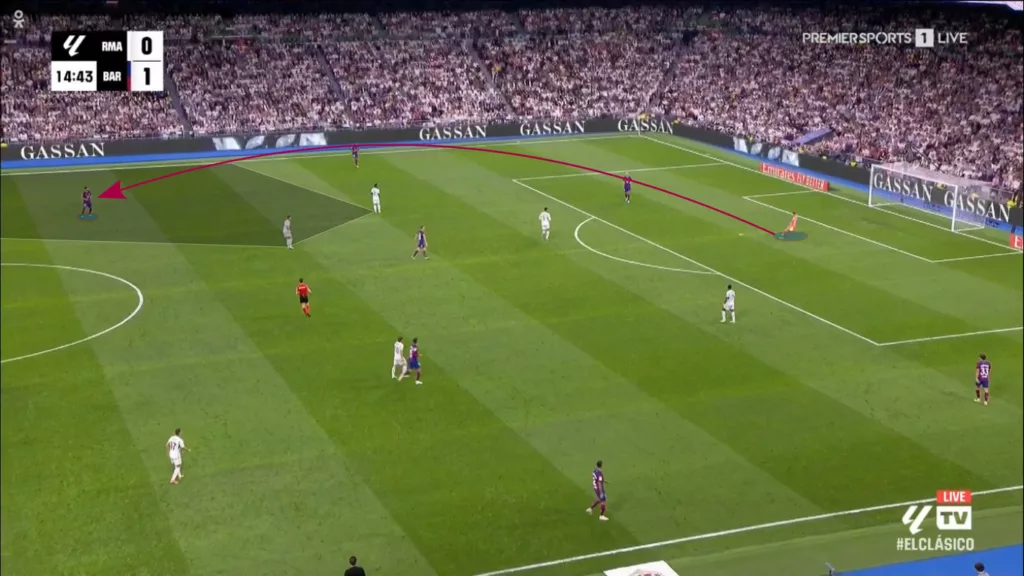
In contrast to many top European teams who have honed their pressing systems to great effect, Madrid’s pressing game under Ancelotti has been a point of concern. While the Italian tactician provides his players with a loose defensive framework and assigns individual responsibilities, the lack of pre-planned pressing triggers has often led to disjointed and ineffective pressing sequences..
One glaring weakness in Madrid’s pressing scheme has been the gaps left out wide between the winger and full-back. This vulnerability was starkly evident in the recent El Clásico encounter against Barcelona, where the lack of coordination between players allowed gaps to be exploited by the opposition. When the winger advanced to press or support a press without the full-back providing cover, Madrid were left vulnerable to quick transitions and incisive attacks down the flanks.
The repercussions of this disjointed pressing approach were further highlighted by Barcelona’s ability to exploit spaces and create scoring opportunities, albeit not to their fullest extent. Real Madrid’s reactive defending in such situations often resulted in a loss of control and allowed opponents to find openings in their defensive block.
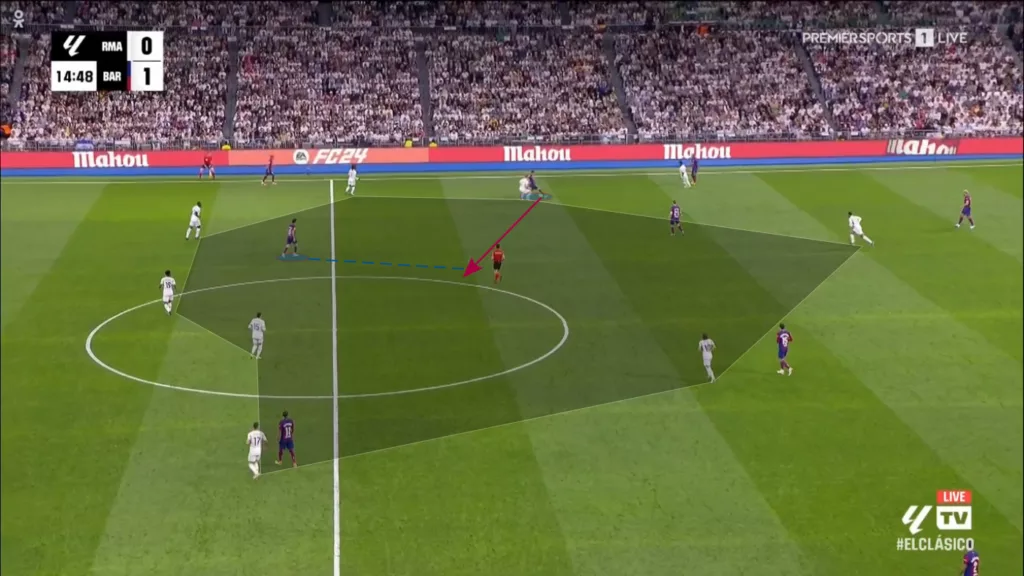
Recognizing the pressing flaws as a significant weakness in their game, Madrid adjusted their approach in the Champions League quarter-final second leg against Manchester City, opting for a more conservative defensive strategy with minimal pressing.
Centre-Back Deficiencies: A Critical Area for Real Madrid’s Summer Reinforcement
While Real Madrid’s defensive solidity has been commended in recent outings, particularly in their midweek performance against Manchester City, there are lingering concerns regarding their effectiveness, particularly in the center-back position. Despite conceding just one goal against Manchester City, statistical metrics reveal vulnerabilities that cannot be overlooked.
Real Madrid’s defensive resilience has been somewhat overshadowed by the absence of Éder Militão due to injury, leaving Antonio Rüdiger with an inconsistent partner at the heart of their defense. In the absence of a reliable center-back pairing, makeshift solutions have been employed, as evidenced by midfielder Aurélien Tchouaméni’s deployment in the right-center-back role during El Clásico.
The lack of depth and quality in the center-back department is a glaring deficiency in Madrid’s squad building this season. With only David Alaba and Nacho Fernández as viable alternatives, Carlo Ancelotti faces limited options, both of whom are not traditional center-backs and may not offer the desired stability in defense.
Against Manchester City, Real Madrid’s defensive vulnerabilities were highlighted by an xGA tally of 2.74 and 33 shots conceded, with 24 coming from inside the box. These statistics underscore the urgent need for reinforcements in the center-back position to shore up the defensive line and provide Rüdiger with a consistent and capable partner.
As Real Madrid look ahead to the summer transfer window, addressing the center-back deficiencies must be a priority. Whether through the acquisition of a proven center-back or the promotion of talent from within the ranks, bolstering the defensive ranks will be crucial in maintaining defensive stability and competitiveness in crucial fixtures, particularly in the Champions League.
Failure to address the center-back deficiencies could prove costly in the high-stakes Champions League fixtures looming on the horizon.
What’s Next for Real Madrid? Addressing Defensive Concerns and Champions League Ambitions
As Real Madrid bask in their dominant position in La Liga, the summer presents an opportunity to address lingering defensive concerns and fortify their position as contenders in the Champions League.
Despite their domestic superiority, Madrid’s defensive vulnerabilities, particularly in pressing situations and the lack of depth at center-back, have been exposed on occasions. To maintain their competitiveness at the highest level, bolstering the defensive side of their game should be a priority in the transfer window.
With the impending arrival of Kylian Mbappé adding firepower to an already potent attacking lineup, Madrid’s focus on defensive solidity becomes even more crucial. Accommodating for forwards who may not excel in defensive duties underscores the importance of a more coordinated pressing system under Ancelotti’s guidance.
The lack of squad depth at center-back is a glaring issue that Madrid must address. The transfer window provides an opportunity to secure reinforcements and ensure a more stable defensive setup for the upcoming season. Links to promising young talents in this position indicate proactive steps towards strengthening the squad.
While Madrid’s dominance in Spain is undisputed, their aspirations in the Champions League demand continuous improvement and adaptation. In a competition where tactical prowess and defensive solidity are paramount, Real Madrid must strive to fortify their position as Europe’s elite.
Despite nitpicking defensive issues in their recent Clásico victory, Madrid’s commanding position domestically underscores their dominance. However, the pursuit of Champions League glory demands relentless pursuit of improvement and reinforcement.




